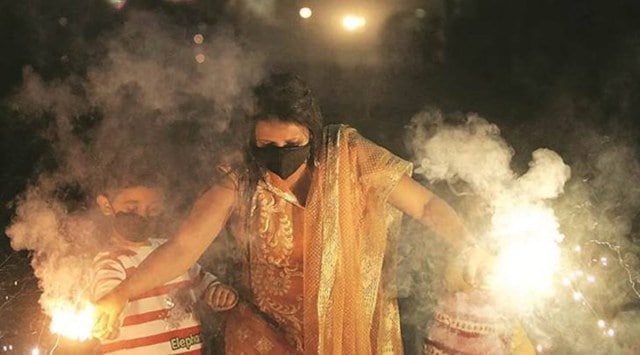- India
- International
Delhi sees best post-Diwali air in 4 years, but ‘poor’ still
Environment minister Gopal Rai said that nearly 70% people did not burn any firecrackers in the city. Deputy Chief Minister Manish Sisodia said many burst crackers in neighbouring states.
 While the AQI is expected to be in the moderate or poor range on Tuesday, a change in wind direction from Wednesday means the relief is only short-lived.
While the AQI is expected to be in the moderate or poor range on Tuesday, a change in wind direction from Wednesday means the relief is only short-lived.Delhi’s air quality improved to the poor category on Monday, the biggest such reduction in pollutant concentration two days after Diwali in four years.
Over the past four years, the concentration of particulate matter has increased the day after Diwali and has taken time to improve thereafter. The improvement has never been from the severe category to poor category within two days since 2015 – which is when a nation-wide air quality index monitoring and reporting system was put in place.
Delhi’s 24-hour average AQI Monday was recorded as 221 — in the poor category. It was 435 on Sunday.
By evening, significant improvement was seen and at 9 pm, the AQI was 196 (moderate). Out of the 36 monitoring stations in Delhi, for which readings were available, 20 were in the moderate category, while 16, including ITO, Nehru Nagar, Aurobindo Marg, Punjabi Bagh and Dwarka, were in the poor category.
At some stations, such as Mandir Marg, India Gate, Aurobindo Marg and Mundka, PM 2.5 levels fell to below 60 microgrammes per cubic metre – the standard limit for PM 2.5 concentration during the day.

While the AQI is expected to be in the moderate or poor range on Tuesday, a change in wind direction from Wednesday means the relief is only short-lived.
“Surface winds are north easterly and strong, very favourable for pollutant dispersion. Scattered rainfall in Delhi and observed surrounding region has washed out some of the pollutants. Effective stubble fire counts with sufficient potential estimated from SAFAR-multi-satellite products are significantly reduced and are around 282. However, in reality, it could be an underestimate due to the inability of satellites to identify spots under cloudy conditions. However, in any case, since boundary layer wind direction is north easterly and not favourable for fire-related transport with higher local dispersal rate, even higher counts could not have changed the conclusion of negligible share of 1% of stubble burning in PM2.5 in Delhi’s air,” officials at SAFAR said.
Kuldeep Srivastava, head of IMD’s regional forecasting centre, said the air quality might deteriorate again on Wednesday. “It rained in Delhi after a gap of two months… and the accumulated pollutants were washed out. The wind direction was also favourable but it is expected to turn to north westerly again and AQI will rise again starting Wednesday,” he said.
Environment minister Gopal Rai said that nearly 70% people did not burn any firecrackers in the city. Deputy Chief Minister Manish Sisodia said many burst crackers in neighbouring states.
The city, meanwhile, is expected to see the minimum temperature dipping to 9 degrees Celsius by the end of the week. On Monday, the maximum temperature was 25.8 degrees Celsius while the minimum was 16 degrees Celsius.
Apr 19: Latest News
- 01
- 02
- 03
- 04
- 05






































